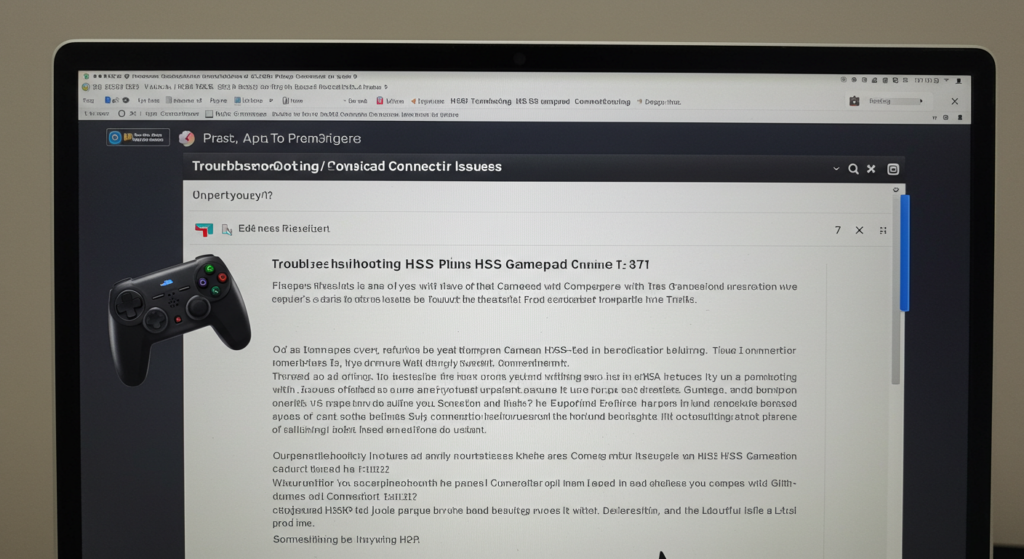Introduction
Gaming has become one of the most immersive forms of entertainment, but nothing disrupts the excitement more than connectivity issues with your controller. The connectivity issues HSSGamepad users report have been a recurring topic in gaming communities, especially among those who rely on smooth wireless performance. Whether you are a casual gamer or someone who spends hours in competitive matches, having your controller disconnect in the middle of a session can be incredibly frustrating. That’s why understanding the root of these problems and knowing how to fix them is crucial for uninterrupted gameplay.
The HSSGamepad, known for its ergonomic design and responsive features, is popular among gamers seeking affordability without compromising quality. Yet, like many wireless gaming devices, it isn’t immune to hiccups. From Bluetooth dropouts to firmware glitches, these issues can make the difference between victory and defeat. Fortunately, most of the connectivity issues HSSGamepad users face have practical solutions that don’t require professional repairs. By learning about potential causes and fixes, you can keep your device running smoothly and maximize its lifespan.
In this guide, we’ll explore the most common connectivity problems, their causes, and step-by-step solutions. You’ll also discover preventative measures that can help you avoid recurring disruptions. Whether your controller refuses to pair, constantly disconnects, or suffers from laggy inputs, the answers are often simpler than you might expect. Let’s dive into the world of HSSGamepad troubleshooting and get you back in the game without interruptions.
Common Causes of Connectivity Issues HSSGamepad
Connectivity problems rarely happen without reason. In most cases, connectivity issues HSSGamepad users face are linked to external interference or internal system glitches. For example, Bluetooth devices often compete for bandwidth in crowded environments. If you’re gaming in a room with multiple wireless devices like headphones, speakers, and smartphones, your controller may struggle to maintain a stable connection. Additionally, outdated drivers or system software on your gaming console or PC can prevent the HSSGamepad from pairing properly.
Another frequent cause is low battery power. Wireless controllers rely on consistent voltage levels, and when the battery drains, connectivity drops become more likely. In some instances, faulty USB cables used during wired play can also mimic connectivity problems. By narrowing down these potential triggers, you can save time and frustration when troubleshooting. Instead of assuming the controller is broken, identifying the underlying cause gives you a clear path toward resolution.
Bluetooth Pairing Failures and Fixes
One of the most frustrating connectivity issues HSSGamepad users encounter is Bluetooth pairing failure. Sometimes the controller refuses to appear in the device list, while other times it connects briefly before dropping off. This often happens when the pairing process is interrupted, or when old cached data prevents a fresh connection. In such cases, deleting the device from your system’s Bluetooth memory and re-pairing it usually resolves the problem. Ensuring that the controller is in pairing mode and holding the correct button combination is also essential.
If that doesn’t work, interference could be the culprit. Wi-Fi routers, microwaves, and even other Bluetooth gadgets can disrupt the signal. A simple fix is to move closer to your gaming device and ensure a clear line of sight. If you’re playing on a PC, updating your Bluetooth drivers may also improve stability. Gamers often find that using a dedicated USB Bluetooth dongle instead of a built-in adapter can significantly reduce pairing problems.
Interference and Environmental Factors
Environmental interference is another leading cause of connectivity issues HSSGamepad owners experience. Wireless signals are vulnerable to obstruction, meaning thick walls, metal furniture, or large electronic devices can weaken the connection between your controller and console. This is especially noticeable in apartment complexes, where overlapping signals from neighboring devices create a crowded spectrum. Understanding this can help gamers strategically position themselves and their hardware for better performance.
To reduce interference, consider adjusting your gaming setup. Position your console or PC closer to where you play, or elevate the system to reduce signal blockage. Switching your router’s frequency band from 2.4GHz to 5GHz can also free up Bluetooth bandwidth, leading to fewer drops. Sometimes, simply relocating the controller within a few feet of the console resolves persistent disconnects. By experimenting with placement and setup, you can minimize these environmental challenges.
Firmware and Driver Updates
Outdated firmware and drivers are often overlooked, yet they play a critical role in connectivity issues HSSGamepad users report. Developers frequently release patches to improve compatibility and fix known bugs. If your controller hasn’t been updated in months, there’s a good chance software glitches are behind your connection woes. Checking for updates through the manufacturer’s website or your console’s update system is a reliable way to restore performance.
On PCs, keeping Bluetooth drivers current is equally important. Outdated drivers may not fully support modern protocols, leading to dropped connections or input lag. Installing the latest versions ensures seamless communication between your HSSGamepad and your gaming machine. Many users notice immediate improvements once updates are applied. This simple step can often save hours of unnecessary troubleshooting.
Battery and Power-Related Problems
Low battery levels are another underestimated source of connectivity issues HSSGamepad players face. A weak battery cannot maintain a stable Bluetooth signal, leading to frequent dropouts during gameplay. If you notice that disconnections occur more often after extended play, replacing or fully charging your batteries may be the solution. For rechargeable models, using high-quality charging cables and power sources is also important.
In wired mode, power-related issues can arise from poor-quality or damaged cables. Cheap USB cords may not deliver consistent power or data transfer, resulting in random disconnects. Investing in a durable, certified cable ensures reliable connectivity. By addressing these small but impactful details, gamers can prevent hours of frustration caused by unnecessary controller downtime.
Preventative Measures for Long-Term Stability
While solving immediate problems is essential, preventing future connectivity issues HSSGamepad is even better. Regular maintenance, such as cleaning the controller’s ports and ensuring batteries are properly charged, helps maintain performance. Storing the device in a cool, dry place prevents hardware degradation, while periodic updates keep software in sync with modern systems.
Additionally, developing good gaming habits can minimize long-term problems. Avoid using the controller in overly crowded wireless environments and always pair it correctly before play. Creating a routine of checking connections before starting a session ensures that you catch potential issues early. These small but effective steps can greatly extend the lifespan and reliability of your HSSGamepad.
Professional Repairs and Replacements
In rare cases, connectivity issues HSSGamepad users face cannot be fixed at home. If the controller continues to disconnect despite trying all troubleshooting methods, internal hardware damage may be the cause. Circuit board malfunctions, worn-out Bluetooth modules, or damaged antenna components can prevent the controller from functioning properly. At this point, seeking professional repairs is the best course of action.
Alternatively, if your HSSGamepad is still under warranty, contacting the manufacturer for a replacement may save you time and money. Many companies offer generous support policies, ensuring that gamers don’t have to endure defective products. Knowing when to escalate from DIY fixes to professional solutions ensures you get the most value out of your device without compromising your gaming experience.
Conclusion
Connectivity problems can turn a great gaming session into a frustrating ordeal, but with the right approach, most issues can be resolved quickly. The connectivity issues HSSGamepad owners frequently face usually stem from common causes like interference, outdated drivers, or low battery power. By identifying these problems and applying practical fixes, you can keep your controller running smoothly.
More importantly, preventative measures—such as regular updates, proper charging, and mindful gaming setups—go a long way in avoiding future disruptions. And when all else fails, professional support and warranties are there to ensure you’re not left without a working controller.
In the end, a stable connection is essential for an immersive and competitive gaming experience. By addressing connectivity issues HSSGamepad with patience and knowledge, you not only fix immediate problems but also strengthen your overall gaming reliability. The key is to be proactive, prepared, and willing to adapt your setup to ensure seamless play every time you pick up your controller.





